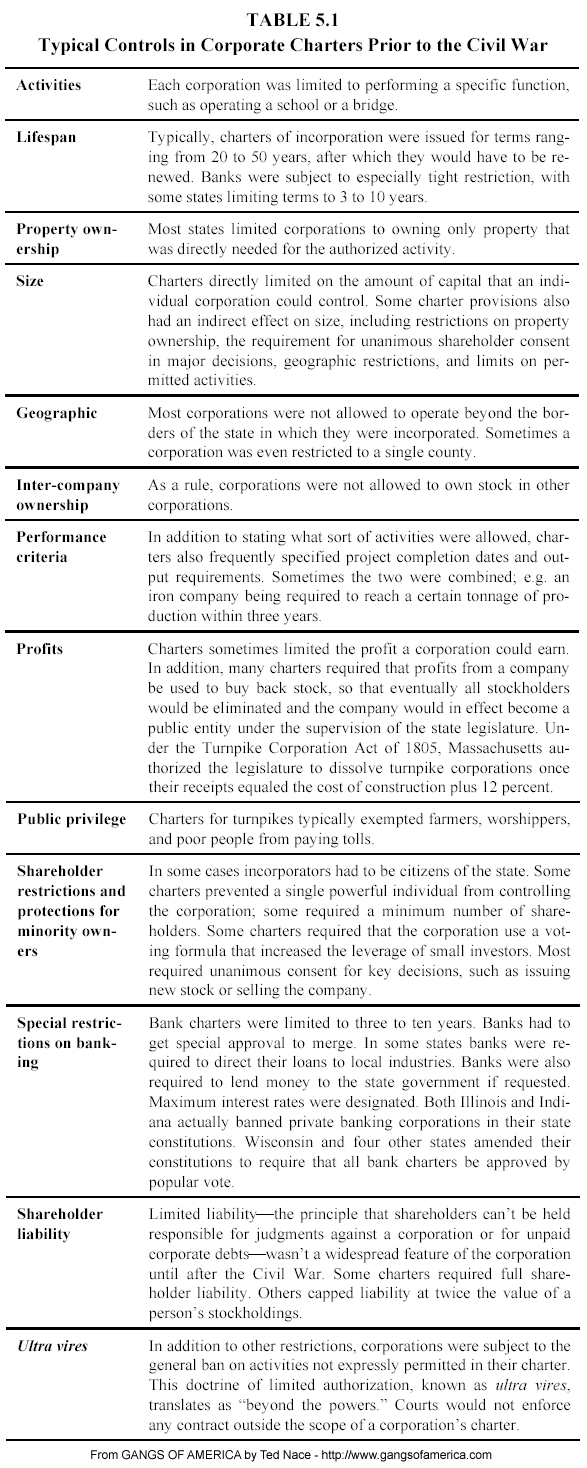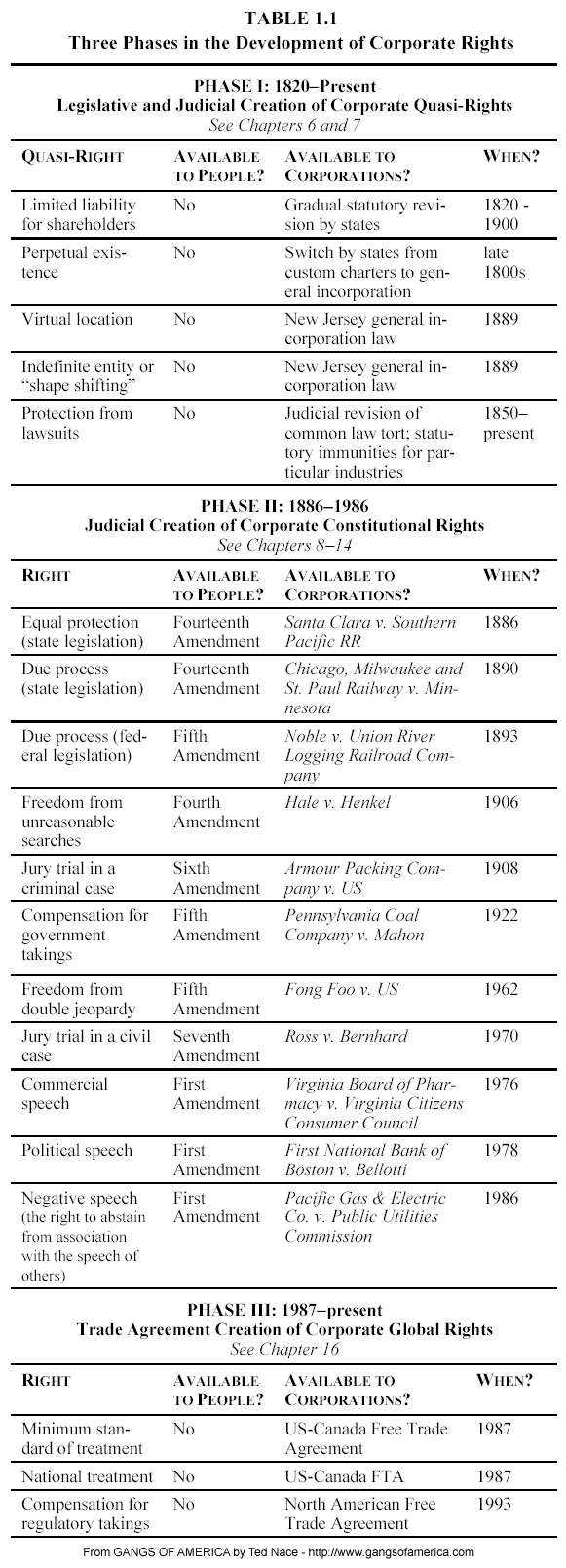
Images and text from Gangs of America: The Rise of Corporate Power and the Disabling of Democracy by Ted Nace, Berrett-Koehler Publishers, September 2003.
I see in the near future a crisis approaching that unnerves me and causes me to tremble for the safety of my country. As a result of the war, corporations have been enthroned and an era of corruption in high places will follow, and the money power of the country will endeavor to prolong its reign by working upon the prejudices of the people until all wealth is aggregated in a few hands and the Republic is destroyed. I feel at this moment more anxiety for the safety of my country than ever before, even in the midst of war. God grant that my suspicions may prove groundless.—Abraham Lincoln, 1864
What is a corporation? Where did corporations come from? How did this particular institution develop? As citizens of a country that prides itself on its economic system, we Americans know a lot less about the institutions that make up that economy than about the institutions that make up our government. And increasingly, that ignorance is proving costly, as we realize the extent to which those “economic” institutions actually are our government.
Even though corporations are not mentioned at all in the Constitution, they have somehow accumulated more legal rights than human beings. How did this happen?
One of the basic reasons for the American Revolution was colonial opposition to corporate power.
"Freed, as such bodies are, from the sure bounds to the schemes of individuals, the grave, they are able to add field to field, and power to power, until they become entirely too strong for that society which is made up of those whose plans are limited by a single life."—Supreme Court of Georgia, Railroad Co. v. Collins
After the Constitutional Convention, the system that emerged for chartering corporations flipped the English system upside down. Instead of the monarch using corporate charters to grant special monopoly privileges to men of wealth, the American system placed the chartering function in the hands of the various state legislatures and placed an emphasis on restrictions and accountability measures, rather than on privileges. State constitutions and statutes reinforced the restrictive stance toward corporations.
Under this system, charters tended to be granted sparingly, in keeping with the widespread belief that the potential for corporations to accumulate power rendered them inherently dangerous to democracy.

- The History of Corporate Power in the U.S.
- Interview with Ted Nace, author of Gangs of America, 1.5hr MP3 Audio
Why was control of the Supreme Court so important to railroad corporations in the 1870s and 1880s?
After all, in the years following the Civil War, the railroads seemed to have little trouble manipulating Congress to do their bidding. Bribery by railroad lobbyists was rampant among Senators and Congressmen. For example, between 1875 and 1885 the Central Pacific spent $500,000 yearly on graft; in a single year, the LaCrosse and Milwaukee Railroad spent $872,000 for influence, including $50,000 for a governor, $10,000 for a state controller, $125,000 for thirteen legislators, etc. Among the fruits of these expenditures by railroad interests were immense land grants. Ultimately, they acquired 200 million acres of land, a tenth of the area of the entire country.
It was at the state level that the railroad barons needed help from a Supreme Court willing to throw thunderbolts from Washington invalidating state legislation on constitutionality grounds.
Historians have known since 1963 that the "corporations are persons" formulation frequently cited in reference to the Santa Clara decision was not actually part of the opinion of the Supreme Court but rather an insertion of words by Chief Court Reporter J. C. Bancroft Davis (former president of the Newburgh & New York Railroad) based on a comment made from the bench by Chief Justice Morrison Waite. Based on this revelation, the legitimacy of Santa Clara as a basis for corporate rights would seem to be in tatters.
Justice Harlan playing an enigmatic role. In May, 1886, he writes an opinion that uses a technical argument to decide the Santa Clara case, declining to use the "personhood" rationale. In November of the same year, we see him citing Santa Clara as a personhood precedent. The particular reasons for his change are unknown.

Revision of New Jersey’s corporate statutes in 1888 and 1889 immediately made that state the venue of choice for corporations wishing to escape more restrictive regulation in other states. By 1901, 71 percent of all United States corporations with assets of $25 million or greater were using New Jersey as their home base. According to corporate lawyer Charles Bostwick, “so many Trusts and big corporations were paying tribute to the State of New Jersey that the authorities had become greatly perplexed as to what should be done with surplus revenue....”
Other states had two choices: either attempt to compete with New Jersey in a “race to the bottom,” or watch locally chartered corporations move their legal home to New Jersey. In 1899, Delaware followed New Jersey, and when Governor Woodrow Wilson tightened the New Jersey law in 1913, Delaware pulled ahead as the corporate venue of choice, a position it retains to this day. A half-dozen other states followed New Jersey and Delaware to relax their corporate statutes. Observing the wreckage to state authority over corporations, journalist Lincoln Steffens dubbed New Jersey “the traitor state.” By making it easy for corporations to hold stock in other corporations, New Jersey’s law opened the door for a huge wave of acquisitions, particularly during the period 1897 to 1903. During that six-year span of time, a dramatic transformation of the American business landscape took place. Some 2,650 separate firms disappeared into larger corporate entities, as industry after industry became dominated by a handful of immense, politically powerful corporations incorporated in states with corporate-friendly statutes. By 1903, some 250 large corporations had emerged as dominant.

Such entities as International Paper (1898), National Sugar Refining Company (1900), U.S. Steel (1901), and International Harvester (1902) were all formed in this period by merging smaller companies into large corporations. In 1890, the aggregate amount of capital in publicly traded companies was a mere $33 million; in 1903, it surpassed $7 billion. Industry after industry had seen a remarkable concentration of market share. U.S. Steel controlled 62 percent of the steelmarket, International Harvester controlled 85 percent of the agricultural implement market, American Can Company controlled 90 percent of the can market, etc.
In a remarkably short span of time, the structure of the American economy had radically changed.
The effects of the legal revolution that had disassembled the “containment vessel” for corporate power, the state-issued charter, could now be seen. In its place, the law now provided a suit of protective armor. Instead of protecting democracy from corporate power, the legal system now shielded corporations from legislative power.
Writes historian Karren Orren: "in every jurisdiction in the United States, not to work or be seeking work, if one was an able-bodied person without other visible means of support, was a crime, punishable by fine or imprisonment."

During his last term in office, Roosevelt proposed a "second Bill of Rights" that would address issues of economic fairness and security. It would guarantee the following:
- the right of all workers to employment at an adequate wage,
- the right of farmers to a decent return on their products,
- the right of small businessmen to protection from monopolies and unfair competition,
- the right of all families to a home,
- the right of everyone to education and medical care, and
- the right of the aged, the disabled, and the unemployed to economic security.
Roosevelt’s wider vision of rights was a natural culmination of a movement that had begun in the 1600s and 1700s to elevate the status of individuals, particularly in relation to powerful institutions.
Roosevelt banished from the public discourse the social Darwinist vision. His genius was the win/win solution, the idea that a well-paid, socially secure workforce was entirely compatible with a huge expansion in corporate activity and profits. Under the approach created by Roosevelt and adhered to by both Democratic and Republican administrations for the next three decades, corporate growth remained brisk and expansion continued at the same time that the distribution of wealth in the United States became far more evenly distributed than before the Great Depression. Thus, while the share of wealth owned by the top one percent of the population was nearly 45 percent in 1929, it had fallen to 20 percent by 1971.
As Franklin Roosevelt once remarked, “necessitous men are not free men.” Similarly, Alexander Hamilton wrote, “the power over a man’s subsistence amounts to a power over his will.”

Just as it was necessary to innovate and implement specific new features in order to democratize and constrain state power, the same applies to corporate power. A short list of changes might include the following:
- revoke the doctrine of corporate constitutional rights;
- curb corporate “quasi-rights” as appropriate, e.g. requiring corporations to renew their charters every five years;
- ban corporations from political activity;
- shore up the boundaries of “non-corporate” spaces in society, e.g. prohibiting advertising aimed at children;
- expand the scope of worker and customer rights vis-à-vis corporations;
- strengthen countervailing institutions, especially unions;
- promote non-corporate institutions like public schools and economic forms like municipal utilities, family farms, consumer cooperatives, employee-run enterprises.

"Strength lies in organization, in careful long-range planning and implementation, in consistency of action over an indefinite period of years, in the scale of financing available only through joint effort, and in the political power available through united action and national organizations."—Lewis Powell